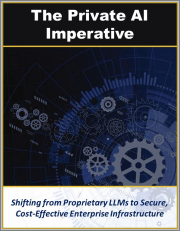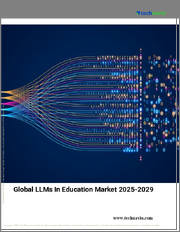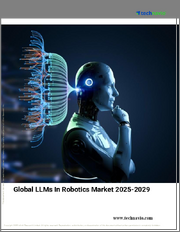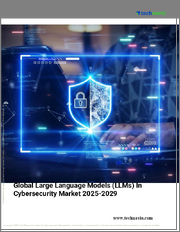
|
시장보고서
상품코드
1589165
세계의 기업용 학습 관리 시스템 시장 : 제공 제품, 학습 모드, 전개, 조직 규모, 최종 사용자별예측(2025-2030년)Corporate Learning Management System Market by Offering (Services, Solutions), Learning Mode (Blended Learning, Distance Learning, Instructor-Led Learning), Deployment, Organization Size, End-User - Global Forecast 2025-2030 |
||||||
기업용 학습 관리 시스템 시장의 2023년 시장 규모는 110억 3,000만 달러로, 2024년에는 133억 2,000만 달러에 달할 것으로 예측되며, 복합 연간 성장률(CAGR) 21.38%로 성장하여 2030년에는 428억 4,000만 달러에 도달할 것으로 예상됩니다.
기업용 학습 관리 시스템(LMS)은 조직 내 직원 교육 및 능력 개발 프로그램을 관리, 제공, 추적하기 위해 만들어진 기술 플랫폼입니다. 기업용 LMS의 범위는 전통적인 교육에 그치지 않고, 켜짐 보딩, 컴플라이언스 교육, 성과 분석, 인재 관리 등의 기능을 포함하여 기업이 경쟁 우위와 법률 준수를 유지하는 데 필수적인 도구 역할을 합니다. 템의 필요성은 세계화, 원격 워크의 상승, 기술의 진보에 수반하는 스킬 개발의 요구의 급속한 증가에 의해 높아지고 있습니다. E-Learning 기술을 홍보하고 직원들이 자신의 속도로 학습하고 성장할 수 있도록 지원합니다. 중요한 부문이 포함됩니다.
| 주요 시장 통계 | |
|---|---|
| 기준년 (2023년) | 110억 3,000만 달러 |
| 예측년(2024년) | 133억 2,000만 달러 |
| 예측년(2030년) | 428억 4,000만 달러 |
| 복합 연간 성장률(CAGR)(%) | 21.38% |
시장 성장은 Ed-Tech에 대한 투자 증가, 인터랙티브 학습 경험을 강화하는 AR/VR의 진보, AI를 활용한 개인화된 학습 경로에 의해 영향을 받고 있습니다. 또한 LMS에 빅데이터 분석을 통합하면 직원 참여 및 교육 효과에 대한 실용적인 인사이트을 얻을 수 있습니다. 모바일 디바이스의 보급과 마이크로러닝 솔루션 수요는 LMS의 기능을 확대할 새로운 기회를 가져왔습니다. 기업은 모바일에 최적화된 컨텐츠에 투자하고 AI 주도 적응 러닝 기능을 개발함으로써 이러한 기회를 포착할 수 있습니다.
그러나 데이터 보안 우려, 다른 기업 시스템과의 통합 복잡성, 조직 내 변화에 대한 저항 등 과제도 남아 있습니다. 이러한 과제는 채용률을 낮추고 시장 성장에 영향을 줄 수 있습니다. 그럼에도 불구하고 기술 혁신과 연구가 필요한 부문으로는 사용자 경험을 향상시키는 직관적인 사용자 인터페이스 개발, 학습자의 참여를 높이는 게이미 피케이션 도입, 다국어 및 이문화 학습 요구를 지원 하는 솔루션 등을 들 수 있습니다.
전반적으로 기업용 LMS 시장은 급속한 기술 진화를 특징으로 하며, 측정 가능한 가치를 제공하는 시스템에 대한 수요가 현저합니다. 경쟁을 유지하고 시장을 선도하기 위해 기업은 컨텐츠 제공업체와 혁신사와의 파트너십을 키우면서 다목적이고 안전한 플랫폼 구축에 주력해야 합니다.
시장 역학 : 급속히 진화하는 기업용 학습관리 시스템 시장의 주요 시장 인사이트 공개
기업용 학습 관리 시스템 시장은 수요 및 공급의 역동적인 상호작용에 의해 변모를 이루고 있습니다. 정밀화 및 새로운 비즈니스 기회 획득에 대비 이러한 동향을 종합적으로 파악함으로써 기업은 정치적, 지리적, 기술적, 사회적, 경제적 영역에 걸친 다양한 위험을 완화할 수 있으며, 또한 소비자 행동 그리고 그것이 제조 비용과 구매 동향에 미치는 영향을보다 명확하게 이해할 수 있습니다.
- 시장 성장 촉진요인
- 스킬 개발을 위한 기업 부문에서의 e러닝 도입 증가
- 학습교재 보관을 위한 모바일 전달 컨텐츠와 함께 개인화된 학습의 가속화
- 기업의 트레이닝 프로그램을 감시, 관리하는 요구의 고조
- 시장 성장 억제요인
- 기업용 학습 관리 플랫폼과 관련된 예산 제약과 가격 차별화
- 시장 기회
- 트레이닝 코스의 프레임워크를 제품화하는 새로운 기업 학습 관리 시스템의 출현
- 차세대 기업 학습 관리 시스템의 지속적인 개발
- 시장의 과제
- 학습 관리 시스템에서 다국어 지원의 부족
Porter's Five Forces : 기업용 학습 관리 시스템 시장을 탐색하는 전략 도구
Porter's Five Forces Framework는 기업용 학습 관리 시스템 시장 경쟁 구도를 이해하는 중요한 도구입니다. 기술을 설명합니다. Porter's Five Forces Framework는 기업이 시장 내 세력도를 평가하고 신규 사업의 수익성을 판단하는 데 도움이 됩니다. 피할 수 있으며 더 강인한 시장에서 포지셔닝을 보장 할 수 있습니다.
PESTLE 분석 : 기업용 학습 관리 시스템 시장에서 외부 영향을 파악
외부 거시 환경 요인은 기업을위한 학습 관리 시스템 시장의 성과 역학을 형성하는데 매우 중요한 역할을 합니다. 이러한 영향을 탐색하는 데 필요한 정보를 제공합니다. PESTLE 요인을 조사하면 기업은 잠재적인 위험과 기회를 더 잘 이해할 수 있습니다. 앞을 내다본 적극적인 의사결정을 할 준비가 되어 있습니다.
시장 점유율 분석 : 기업용 학습 관리 시스템 시장에서 경쟁 구도 파악
기업용 학습 관리 시스템 시장의 상세한 시장 점유율 분석을 통해 공급업체의 성과를 종합적으로 평가할 수 있습니다.의 포지셔닝을 밝혀 이를 통해 시장의 집중, 세분화 및 통합 동향을 밝혀내고, 벤더는 경쟁이 격화하는 가운데 자사의 지위를 높이는 전략적인 의사 결정을 내릴 필요가 있습니다. 지식을 얻을 수 있습니다.
FPNV 포지셔닝 매트릭스 : 기업용 학습 관리 시스템 시장에서 공급업체의 성능 평가
FPNV 포지셔닝 매트릭스는 기업용 학습 관리 시스템 시장에서 공급업체를 평가하는 중요한 도구입니다. 이 행렬을 통해 비즈니스 조직은 공급업체의 비즈니스 전략과 제품 만족도를 기준으로 평가하여 목표에 맞는 충분한 정보를 바탕으로 의사 결정을 내릴 수 있습니다. 네 가지 사분면을 통해 공급업체를 명확하고 정확하게 부문화하고 전략 목표에 가장 적합한 파트너 및 솔루션을 파악할 수 있습니다.
전략 분석 및 추천: 기업용 학습 관리 시스템 시장에서 성공을 위한 길을 그리기
기업용 학습 관리 시스템 시장의 전략분석은 시장에서의 프레즌스 강화를 목표로 하는 기업에 필수적입니다. 주요 자원, 능력 및 성과 지표를 검토함으로써 기업은 성장 기회를 파악하고 개선을 위해 노력할 수 있습니다. 이 접근법을 통해 경쟁 구도에서 과제를 극복하고 새로운 비즈니스 기회를 활용하여 장기적인 성공을 거둘 수 있는 체제를 마련할 수 있습니다.
이 보고서는 주요 관심 분야를 다루는 시장에 대한 종합적인 분석을 제공합니다.
1. 시장 침투 : 현재 시장 환경의 상세한 검토, 주요 기업의 광범위한 데이터, 시장 도달범위 및 전반적인 영향력을 평가합니다.
2. 시장 개척도 : 신흥 시장의 성장 기회를 파악하고, 기존 부문에서의 확장 가능성을 평가하며, 미래 성장을 위한 전략적 로드맵을 설명합니다.
3. 시장 다양화 : 최근 제품 출시, 미개척 지역, 산업의 주요 진보, 시장을 형성하는 전략적 투자를 분석합니다.
4. 경쟁 평가 및 정보 : 경쟁 구도를 철저히 분석하여 시장 점유율, 사업 전략, 제품 포트폴리오, 인증, 규제 당국 승인, 특허 동향, 주요 기업의 기술 진보 등을 검증합니다.
5. 제품 개발 및 혁신 : 미래 시장 성장을 가속할 것으로 예상되는 최첨단 기술, R&D 활동, 제품 혁신을 강조합니다.
또한 이해관계자가 충분한 정보를 얻은 후 의사결정할 수 있도록 중요한 질문에도 대답하고 있습니다.
1. 현재 시장 규모와 향후 성장 예측은?
2. 최고의 투자 기회를 제공하는 제품, 지역은 어디입니까?
3. 시장을 형성하는 주요 기술 동향과 규제의 영향은?
4. 주요 벤더의 시장 점유율과 경쟁 포지션은?
5. 벤더 시장 진입, 철수 전략의 원동력이 되는 수익원과 전략적 기회는 무엇인가?
목차
제1장 서문
제2장 조사 방법
제3장 주요 요약
제4장 시장 개요
제5장 시장 인사이트
- 시장 역학
- 성장 촉진요인
- 스킬 개발을 위한 기업 부문에서의 e러닝 도입 증가
- 학습 교재의 보존을 위한 모바일 전달 컨텐츠와 조합한 개인화된 학습의 가속
- 기업 연수 프로그램의 감시와 관리의 필요성이 높아진다
- 억제요인
- 기업 학습 관리 플랫폼과 관련된 예산 제약과 가격 차별화
- 기회
- 연수 코스의 프레임워크를 제품화하는 새로운 기업 학습 관리 시스템의 출현
- 차세대 기업 학습 관리 시스템의 지속적인 개발
- 과제
- 학습 관리 시스템에서 다국어 지원의 부족
- 성장 촉진요인
- 시장 세분화 분석
- Porter's Five Forces 분석
- PESTEL 분석
- 정치
- 경제
- 사회
- 기술
- 법률
- 환경
제6장 기업용 학습 관리 시스템 시장 : 제공 제품별
- 소개
- 서비스
- 컨설팅 서비스
- 구현 서비스
- 지원 서비스
- 교육 및 교육 서비스
- 솔루션
- 통합형
- 독립형
제7장 기업용 학습 관리 시스템 시장 : 학습 형태별
- 소개
- 블렌드형 학습
- 원격 학습
- 강사 주도 학습
제8장 기업용 학습 관리 시스템 시장 : 전개별
- 소개
- 클라우드
- 온프레미스
제9장 기업용 학습 관리 시스템 시장 : 조직 규모별
- 소개
- 대기업
- 중소기업
제10장 기업용 학습 관리 시스템 시장 : 최종 사용자별
- 소개
- 은행/금융서비스/보험
- 정부와 홍보
- 의료
- 접객
- 정보기술
- 제조업
제11장 아메리카 기업용 학습 관리 시스템 시장
- 소개
- 아르헨티나
- 브라질
- 캐나다
- 멕시코
- 미국
제12장 아시아태평양 기업용 학습 관리 시스템 시장
- 소개
- 호주
- 중국
- 인도
- 인도네시아
- 일본
- 말레이시아
- 필리핀
- 싱가포르
- 한국
- 대만
- 태국
- 베트남
제13장 유럽, 중동 및 아프리카 기업용 학습 관리 시스템 시장
- 소개
- 덴마크
- 이집트
- 핀란드
- 프랑스
- 독일
- 이스라엘
- 이탈리아
- 네덜란드
- 나이지리아
- 노르웨이
- 폴란드
- 카타르
- 러시아
- 사우디아라비아
- 남아프리카
- 스페인
- 스웨덴
- 스위스
- 터키
- 아랍에미리트(UAE)
- 영국
제14장 경쟁 구도
- 시장 점유율 분석(2023년)
- FPNV 포지셔닝 매트릭스(2023년)
- 경쟁 시나리오 분석
- 전략 분석과 제안
기업 목록
- 360Learning
- Absorb Software Inc.
- Adobe Inc.
- AlphaLearn
- Auzmor Inc.
- Coassemble Pty Ltd.
- Cornerstone OnDemand, Inc.
- CrossKnowledge by John Wiley & Sons, Inc.
- D2L Corporation
- Docebo SpA
- Easy LMS BV
- Epignosis LLC
- Fingent Corporation
- G-Cube Webwide Software Pvt Ltd. by MRCC Group
- Hurix Systems Pvt. Ltd.
- imc AG by Scheer GmbH
- Infor
- Instructure, Inc.
- International Business Machines Corporation
- iSpring Solutions, Inc.
- JZero Solutions Ltd.
- Latitude CG, LLC
- Learning Pool Limited
- Learning Technologies Group PLC
- LearnUpon Limited
- Litmos US, LP
- Moodle Pty Ltd.
- Novac Learning
- Paradiso Solutions Corporation
- Pursuit Technology Australia Pty Ltd.
The Corporate Learning Management System Market was valued at USD 11.03 billion in 2023, expected to reach USD 13.32 billion in 2024, and is projected to grow at a CAGR of 21.38%, to USD 42.84 billion by 2030.
A corporate learning management system (LMS) is a technology platform created to manage, deliver, and track employee training and development programs within an organization. The scope of a corporate LMS extends beyond traditional training to include features like onboarding, compliance training, performance analytics, and talent management, serving as an integral tool for companies to maintain competitive advantage and regulatory compliance. The necessity of such systems has grown due to globalization, the rise of remote work, and the fast-paced need for skill development amid technological advancements. Corporations across various sectors employ LMS to facilitate blended and e-learning methodologies, allowing employees to learn and grow at their own pace. Key end-users include sectors such as manufacturing, healthcare, IT, and finance where ongoing professional development is crucial.
| KEY MARKET STATISTICS | |
|---|---|
| Base Year [2023] | USD 11.03 billion |
| Estimated Year [2024] | USD 13.32 billion |
| Forecast Year [2030] | USD 42.84 billion |
| CAGR (%) | 21.38% |
Market growth is being influenced by increasing investments in ed-tech, advancements in AR/VR that enhance interactive learning experiences, and AI-powered personalized learning paths. Also, the integration of big data analytics in LMS helps in deriving actionable insights about employee engagement and training effectiveness. The proliferation of mobile devices and the demand for microlearning solutions present new opportunities to expand LMS capabilities. Companies can seize these opportunities by investing in mobile-optimized content and developing AI-driven adaptive learning features.
However, challenges persist, including data security concerns, integration complexities with other corporate systems, and resistance to change within organizations. These challenges can stifle adoption rates and impact market growth. Nevertheless, areas ripe for innovation and research include the development of intuitive user interfaces to improve user experience, incorporation of gamification to enhance learner engagement, and solutions that support multi-language and cross-cultural learning needs.
Overall, the corporate LMS market is characterized by rapid technological evolution and is marked by the demand for systems that deliver measurable value. To maintain competitiveness and drive market leadership, businesses should focus on creating versatile and secure platforms while fostering partnerships with content providers and tech innovators.
Market Dynamics: Unveiling Key Market Insights in the Rapidly Evolving Corporate Learning Management System Market
The Corporate Learning Management System Market is undergoing transformative changes driven by a dynamic interplay of supply and demand factors. Understanding these evolving market dynamics prepares business organizations to make informed investment decisions, refine strategic decisions, and seize new opportunities. By gaining a comprehensive view of these trends, business organizations can mitigate various risks across political, geographic, technical, social, and economic domains while also gaining a clearer understanding of consumer behavior and its impact on manufacturing costs and purchasing trends.
- Market Drivers
- Rising adoption of eLearning in corporate sector for skill development
- Acceleration of personalized learning coupled with mobile delivery content for storage of learning materials
- Growing need to monitor and manage corporate training programs
- Market Restraints
- Budget constraints and pricing differentiation associated with corporate learning management platforms
- Market Opportunities
- Emergence of new corporate learning management systems to productize framework of training courses
- Ongoing development of next-generation corporate learning management systems
- Market Challenges
- Lack of multi-language support in learning management systems
Porter's Five Forces: A Strategic Tool for Navigating the Corporate Learning Management System Market
Porter's five forces framework is a critical tool for understanding the competitive landscape of the Corporate Learning Management System Market. It offers business organizations with a clear methodology for evaluating their competitive positioning and exploring strategic opportunities. This framework helps businesses assess the power dynamics within the market and determine the profitability of new ventures. With these insights, business organizations can leverage their strengths, address weaknesses, and avoid potential challenges, ensuring a more resilient market positioning.
PESTLE Analysis: Navigating External Influences in the Corporate Learning Management System Market
External macro-environmental factors play a pivotal role in shaping the performance dynamics of the Corporate Learning Management System Market. Political, Economic, Social, Technological, Legal, and Environmental factors analysis provides the necessary information to navigate these influences. By examining PESTLE factors, businesses can better understand potential risks and opportunities. This analysis enables business organizations to anticipate changes in regulations, consumer preferences, and economic trends, ensuring they are prepared to make proactive, forward-thinking decisions.
Market Share Analysis: Understanding the Competitive Landscape in the Corporate Learning Management System Market
A detailed market share analysis in the Corporate Learning Management System Market provides a comprehensive assessment of vendors' performance. Companies can identify their competitive positioning by comparing key metrics, including revenue, customer base, and growth rates. This analysis highlights market concentration, fragmentation, and trends in consolidation, offering vendors the insights required to make strategic decisions that enhance their position in an increasingly competitive landscape.
FPNV Positioning Matrix: Evaluating Vendors' Performance in the Corporate Learning Management System Market
The Forefront, Pathfinder, Niche, Vital (FPNV) Positioning Matrix is a critical tool for evaluating vendors within the Corporate Learning Management System Market. This matrix enables business organizations to make well-informed decisions that align with their goals by assessing vendors based on their business strategy and product satisfaction. The four quadrants provide a clear and precise segmentation of vendors, helping users identify the right partners and solutions that best fit their strategic objectives.
Strategy Analysis & Recommendation: Charting a Path to Success in the Corporate Learning Management System Market
A strategic analysis of the Corporate Learning Management System Market is essential for businesses looking to strengthen their global market presence. By reviewing key resources, capabilities, and performance indicators, business organizations can identify growth opportunities and work toward improvement. This approach helps businesses navigate challenges in the competitive landscape and ensures they are well-positioned to capitalize on newer opportunities and drive long-term success.
Key Company Profiles
The report delves into recent significant developments in the Corporate Learning Management System Market, highlighting leading vendors and their innovative profiles. These include 360Learning, Absorb Software Inc., Adobe Inc., AlphaLearn, Auzmor Inc., Coassemble Pty Ltd., Cornerstone OnDemand, Inc., CrossKnowledge by John Wiley & Sons, Inc., D2L Corporation, Docebo S.p.A., Easy LMS B.V., Epignosis LLC, Fingent Corporation, G-Cube Webwide Software Pvt Ltd. by MRCC Group, Hurix Systems Pvt. Ltd., imc AG by Scheer GmbH, Infor, Instructure, Inc., International Business Machines Corporation, iSpring Solutions, Inc., JZero Solutions Ltd., Latitude CG, LLC, Learning Pool Limited, Learning Technologies Group PLC, LearnUpon Limited, Litmos US, L.P., Moodle Pty Ltd., Novac Learning, Paradiso Solutions Corporation, and Pursuit Technology Australia Pty Ltd..
Market Segmentation & Coverage
This research report categorizes the Corporate Learning Management System Market to forecast the revenues and analyze trends in each of the following sub-markets:
- Based on Offering, market is studied across Services and Solutions. The Services is further studied across Consulting Services, Implementation Services, Support Services, and Training & Education Services. The Solutions is further studied across Integrated and Standalone.
- Based on Learning Mode, market is studied across Blended Learning, Distance Learning, and Instructor-Led Learning.
- Based on Deployment, market is studied across On-Cloud and On-Premise.
- Based on Organization Size, market is studied across Large Enterprises and Small & Medium Enterprises.
- Based on End-User, market is studied across Banking, Financial Services & Insurance, Government & Public Relations, Healthcare, Hospitality, Information Technology, and Manufacturing.
- Based on Region, market is studied across Americas, Asia-Pacific, and Europe, Middle East & Africa. The Americas is further studied across Argentina, Brazil, Canada, Mexico, and United States. The United States is further studied across California, Florida, Illinois, New York, Ohio, Pennsylvania, and Texas. The Asia-Pacific is further studied across Australia, China, India, Indonesia, Japan, Malaysia, Philippines, Singapore, South Korea, Taiwan, Thailand, and Vietnam. The Europe, Middle East & Africa is further studied across Denmark, Egypt, Finland, France, Germany, Israel, Italy, Netherlands, Nigeria, Norway, Poland, Qatar, Russia, Saudi Arabia, South Africa, Spain, Sweden, Switzerland, Turkey, United Arab Emirates, and United Kingdom.
The report offers a comprehensive analysis of the market, covering key focus areas:
1. Market Penetration: A detailed review of the current market environment, including extensive data from top industry players, evaluating their market reach and overall influence.
2. Market Development: Identifies growth opportunities in emerging markets and assesses expansion potential in established sectors, providing a strategic roadmap for future growth.
3. Market Diversification: Analyzes recent product launches, untapped geographic regions, major industry advancements, and strategic investments reshaping the market.
4. Competitive Assessment & Intelligence: Provides a thorough analysis of the competitive landscape, examining market share, business strategies, product portfolios, certifications, regulatory approvals, patent trends, and technological advancements of key players.
5. Product Development & Innovation: Highlights cutting-edge technologies, R&D activities, and product innovations expected to drive future market growth.
The report also answers critical questions to aid stakeholders in making informed decisions:
1. What is the current market size, and what is the forecasted growth?
2. Which products, segments, and regions offer the best investment opportunities?
3. What are the key technology trends and regulatory influences shaping the market?
4. How do leading vendors rank in terms of market share and competitive positioning?
5. What revenue sources and strategic opportunities drive vendors' market entry or exit strategies?
Table of Contents
1. Preface
- 1.1. Objectives of the Study
- 1.2. Market Segmentation & Coverage
- 1.3. Years Considered for the Study
- 1.4. Currency & Pricing
- 1.5. Language
- 1.6. Stakeholders
2. Research Methodology
- 2.1. Define: Research Objective
- 2.2. Determine: Research Design
- 2.3. Prepare: Research Instrument
- 2.4. Collect: Data Source
- 2.5. Analyze: Data Interpretation
- 2.6. Formulate: Data Verification
- 2.7. Publish: Research Report
- 2.8. Repeat: Report Update
3. Executive Summary
4. Market Overview
5. Market Insights
- 5.1. Market Dynamics
- 5.1.1. Drivers
- 5.1.1.1. Rising adoption of eLearning in corporate sector for skill development
- 5.1.1.2. Acceleration of personalized learning coupled with mobile delivery content for storage of learning materials
- 5.1.1.3. Growing need to monitor and manage corporate training programs
- 5.1.2. Restraints
- 5.1.2.1. Budget constraints and pricing differentiation associated with corporate learning management platforms
- 5.1.3. Opportunities
- 5.1.3.1. Emergence of new corporate learning management systems to productize framework of training courses
- 5.1.3.2. Ongoing development of next-generation corporate learning management systems
- 5.1.4. Challenges
- 5.1.4.1. Lack of multi-language support in learning management systems
- 5.1.1. Drivers
- 5.2. Market Segmentation Analysis
- 5.3. Porter's Five Forces Analysis
- 5.3.1. Threat of New Entrants
- 5.3.2. Threat of Substitutes
- 5.3.3. Bargaining Power of Customers
- 5.3.4. Bargaining Power of Suppliers
- 5.3.5. Industry Rivalry
- 5.4. PESTLE Analysis
- 5.4.1. Political
- 5.4.2. Economic
- 5.4.3. Social
- 5.4.4. Technological
- 5.4.5. Legal
- 5.4.6. Environmental
6. Corporate Learning Management System Market, by Offering
- 6.1. Introduction
- 6.2. Services
- 6.2.1. Consulting Services
- 6.2.2. Implementation Services
- 6.2.3. Support Services
- 6.2.4. Training & Education Services
- 6.3. Solutions
- 6.3.1. Integrated
- 6.3.2. Standalone
7. Corporate Learning Management System Market, by Learning Mode
- 7.1. Introduction
- 7.2. Blended Learning
- 7.3. Distance Learning
- 7.4. Instructor-Led Learning
8. Corporate Learning Management System Market, by Deployment
- 8.1. Introduction
- 8.2. On-Cloud
- 8.3. On-Premise
9. Corporate Learning Management System Market, by Organization Size
- 9.1. Introduction
- 9.2. Large Enterprises
- 9.3. Small & Medium Enterprises
10. Corporate Learning Management System Market, by End-User
- 10.1. Introduction
- 10.2. Banking, Financial Services & Insurance
- 10.3. Government & Public Relations
- 10.4. Healthcare
- 10.5. Hospitality
- 10.6. Information Technology
- 10.7. Manufacturing
11. Americas Corporate Learning Management System Market
- 11.1. Introduction
- 11.2. Argentina
- 11.3. Brazil
- 11.4. Canada
- 11.5. Mexico
- 11.6. United States
12. Asia-Pacific Corporate Learning Management System Market
- 12.1. Introduction
- 12.2. Australia
- 12.3. China
- 12.4. India
- 12.5. Indonesia
- 12.6. Japan
- 12.7. Malaysia
- 12.8. Philippines
- 12.9. Singapore
- 12.10. South Korea
- 12.11. Taiwan
- 12.12. Thailand
- 12.13. Vietnam
13. Europe, Middle East & Africa Corporate Learning Management System Market
- 13.1. Introduction
- 13.2. Denmark
- 13.3. Egypt
- 13.4. Finland
- 13.5. France
- 13.6. Germany
- 13.7. Israel
- 13.8. Italy
- 13.9. Netherlands
- 13.10. Nigeria
- 13.11. Norway
- 13.12. Poland
- 13.13. Qatar
- 13.14. Russia
- 13.15. Saudi Arabia
- 13.16. South Africa
- 13.17. Spain
- 13.18. Sweden
- 13.19. Switzerland
- 13.20. Turkey
- 13.21. United Arab Emirates
- 13.22. United Kingdom
14. Competitive Landscape
- 14.1. Market Share Analysis, 2023
- 14.2. FPNV Positioning Matrix, 2023
- 14.3. Competitive Scenario Analysis
- 14.4. Strategy Analysis & Recommendation
Companies Mentioned
- 1. 360Learning
- 2. Absorb Software Inc.
- 3. Adobe Inc.
- 4. AlphaLearn
- 5. Auzmor Inc.
- 6. Coassemble Pty Ltd.
- 7. Cornerstone OnDemand, Inc.
- 8. CrossKnowledge by John Wiley & Sons, Inc.
- 9. D2L Corporation
- 10. Docebo S.p.A.
- 11. Easy LMS B.V.
- 12. Epignosis LLC
- 13. Fingent Corporation
- 14. G-Cube Webwide Software Pvt Ltd. by MRCC Group
- 15. Hurix Systems Pvt. Ltd.
- 16. imc AG by Scheer GmbH
- 17. Infor
- 18. Instructure, Inc.
- 19. International Business Machines Corporation
- 20. iSpring Solutions, Inc.
- 21. JZero Solutions Ltd.
- 22. Latitude CG, LLC
- 23. Learning Pool Limited
- 24. Learning Technologies Group PLC
- 25. LearnUpon Limited
- 26. Litmos US, L.P.
- 27. Moodle Pty Ltd.
- 28. Novac Learning
- 29. Paradiso Solutions Corporation
- 30. Pursuit Technology Australia Pty Ltd.



















